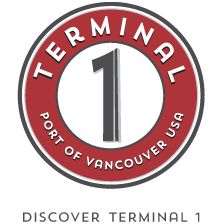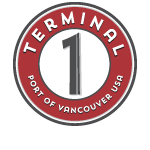Frequently Asked Questions
Terminal 1 at the Port of Vancouver USA is deeply tied to local history and regional economic impact. From its beginning in the early 20th century to present day, port management has been instrumentally important to public land use, waterway management, and regional commerce.
Terminal 1 is the port’s original marine terminal and signature waterfront redevelopment project. The Port of Vancouver adopted a new Strategic Plan in 2018 that identified future development of the Terminal 1 area as one of its Strategic Goals. The location of Terminal 1 is on the Columbia River, immediately west of the I-5 bridge and welcomes visitors to the community and represents the area’s rich history and culture.
Full build out of the site will include the AC Hotel by Marriott, office, residential and retail space, public art, outdoor gathering areas, walking trails, and a public market featuring local artisans, fresh foods and restaurants.
Terminal 1 is the Port of Vancouver’s birthplace. It’s where the port established its first facilities – in partnership with the city of Vancouver – in 1925. Terminal 1 has been home to a prune warehouse, wartime shipbuilding, and the first Red Lion hotel in Washington state. This history is extremely important to the port and the planned redevelopment will help us better share this history with our community and visitors.
Terminal 1 is not the same as the Vancouver Waterfront, though it has been mistaken many times as being part of that private development immediately to the west of the Terminal 1 Property.
Terminal 1 was the Port of Vancouver USA’s original warehouse starting work in the 1920s as a distribution hub for timber, grains and most notably prunes which were shipped from Vancouver throughout the world. The site also served as home to the Standifur shipyards where large wooden ships were built to support the US war effort in WWI.
In 2015, as plans to redevelop the property came into being, the Red Lion Inn, longtime operator at the site, opted to let its lease expire, shuttering operations at the facility. The hotel was deconstructed in 2022 to prepare the site for the dock to be rebuilt for a future public marketplace.
The Quay Restaurant and Bar were operated by Red Lion and closed when the hotel shuttered operations. The port then entered into a lease with local restaurant owner Mark Mathias who revisioned the restaurant into Warehouse ’23, which operated on the site until 2020.
Terminal 1 continues to serve ships today, just not those of the cargo variety. Terminal 1 is the home port of the American Empress Columbia River cruise ship and also serves smaller pleasure craft. Cargo shipping at Terminal 1 ended in the 1950s as the port moved its marine industrial operations to the west.
Largely, the Port of Vancouver is a cargo port, but the American Empress operates out of Terminal 1 running cruises on the Columbia River from March to November. Each cruise carries roughly 220 passengers and each cruise is approximately a week in duration.
The Port of Vancouver believes that environmental stewardship and economic development can co-exist, and as part of our community, we are committed to doing our part. As of September 2019, we are pleased to announce that Terminal 1 has been certified LEED-ND Gold by the US Green Building Council (USGBC). LEED certification is a globally recognized symbol of sustainability achievement.
Find more information on our Sustainability page.
Yes. Currently the lower dock at Terminal 1 is open for day use.
With the construction projects occurring onsite, tours of Terminal 1 are not available at this time. If you would like to learn more about your port, visit https://www.portvanusa.com/community/know-your-port/ to find more information and sign up for a tour of the Port of Vancouver.
From I-5 Northbound:
Take exit 1B toward City Center/Convention Center, take a slight left onto E 6th Street, turn left onto Columbia Street, turn right onto Columbia Way. Terminal 1 will be on your left.
From I-5 Southbound:
Take exit 1C for WA-501/E 15th Street/Mill Plain Blvd, merge onto WA-501/E 15th Street/Mill Plain Blvd, turn left onto Columbia Street, turn right onto Columbian Way. Terminal 1 will be on your left.
No. No events can be held at Terminal 1 currently due to construction underway at the site.
The Port of Vancouver USA owns all the property at Terminal 1.
We are an independent public agency, established in 1912, with a mission of providing economic benefit to our community through leadership, stewardship and partnership in marine, industrial and waterfront development.
Please call the port’s general phone number, 360-693-3611, which is staffed during normal business hours and managed by security personnel at other times. We also welcome inquiries or comments at info@portvanusa.com, which is monitored daily and comments are routed to the appropriate person or organization for response.
Next door to Terminal 1 is a 35-acre development under construction by Columbia Waterfront LLC. The port has been working with both organizations for a decade to lay the groundwork – parcels, roads, rail lines and utilities – to help reconnect our community to the waterfront. The city’s project will soon be home to jobs, restaurants, shops, housing, a hotel, and a 7-acre public park. The port is working closely with the city and Columbia Waterfront LLC so each project fits seamlessly together and creates a waterfront experience unique to our community. The result will be a newly revitalized, vibrant section of the waterfront stretching along the newly constructed Columbia Way from Columbia Street to Esther Street.
Port staff and leadership have been out in the community, speaking to various groups about the project and soliciting feedback. The port also hosts public comment periods at each of our twice-monthly Board of Commissioners meetings, where citizens are welcome to comment on any port subject. Dates and times of these meetings can be found on the port’s main webpage, www.portvanusa.com.
If you would like to schedule a briefing on the port’s waterfront project for your group, please contact Community Relations Manager Julie Rawls at 360-823-5297 or jrawls@portvanusa.com.
Julie Rawls, Community Relations Manager: 360-823-5297, or jrawls@portvanusa.com; Jim Hagar, Economic Development Project Manager: 360-823-5313, or jhagar@portvanusa.com
In going forward with the redevelopment of Terminal 1, the port made certain commitments to the community about the overall development including the public spaces. The weight of this commitment has attracted local developers to invest in Vancouver and SW Washington.
Private construction and development will be key to the physical footprint and economic transformation of Terminal 1. Once completed, the privately developed projects are estimated to total 1.7 million square feet of new construction with a total construction cost of $530 million.
While private development will add many attractive commercial features, such as restaurants and retail spaces, the port will provide resources to develop the public amenities, such as walking trails, outdoor gathering areas, public art and a public market.
This public/private partnership is vital to the Terminal 1 project.
The port will use some of their general obligation bonds to finance the public improvements at Terminal 1, but this will not cover all the funding needed. An additional financing tool is needed to supplement the port’s dollars.
The Washington legislature has created the authority for a city, county, or port to create a tax increment area (TIA) to fund public improvements that help create the ability for new private development to occur.
All increment areas must have a specified boundary, a set duration, and a specific list of projects to accomplish. In this case the specific tax increment area is the property encompassing the port’s Terminal 1 project, with a time frame for the port’s proposed increment area of 25 years.
While private developers are already undertaking some projects in Terminal 1, creating both temporary construction jobs and long-term jobs, the port itself is committed to the construction of a new high dock that is slated for the future development of a public market.
The port will also begin much-needed land improvements in the Terminal 1 area. These include removal of old wooden piles and ground stabilization that will provide a stable foundation for new development on the site.
Additionally, construction will take place on the Renaissance Trail, connecting it to points east and west, as well as the Central Plaza, Daniels Way and the East Portal. All of this work is necessary to providing increased access in the area and public spaces that that help create an inviting waterfront and recreational opportunities.
These projects will benefit the entire community but private development alone will not cover the costs of the entire build-out.
The additional funding source of the tax increment area tool would allow the public amenity projects to be moved up in time so that the community can enjoy these features sooner. Rather than take 15 years or more, the funding would allow the projects to be completed in approximately six years. These projects will expand the connection of Vancouver’s citizens to the waterfront and add vibrancy and an enhanced lifestyle to the waterfront.
TIA’s in Washington can be used for specific purposes. In Terminal 1, these improvements will include streets, sidewalks, dock facilities, park and community facilities, and recreation areas.
The proposed area at Terminal 1 includes the six blocks under port ownership and the area within the Columbia River where a new dock would be constructed that will house the proposed public market.
No. Property taxes will not increase because of an increment area. The source of the revenue is the property taxing districts such as the city of Vancouver and Clark County, not the property taxpayers.
Increment areas redirect a portion of the property taxes that the taxing districts would otherwise have received to the governing body managing the increment area. The diverted property tax revenues can then be used only on specific projects within the increment areas.
In the case of the port, the property taxes collected on the new development in the Terminal 1 boundary will be allocated to the port. The use of these revenues is limited to help fund the construction of the public amenities on Terminal 1.
Currently, there are no taxes being assessed at the Terminal 1 site. In the proposed tax increment area, all increased property taxes from new development in Terminal 1 will go to the port. This allocation of increased property tax revenues from the new assessed value each year will occur until the increment area expires 25 years after receiving its first increment. Once the increment area has expired, the overlapping taxing districts such as the city and county and will receive the full amount of property taxes from the increased assessed value in the increment area.
These taxing districts temporarily forego the increase in tax revenue from the tax increment area and the dollars are directed toward public infrastructure improvements in the tax increment area.
The governing body adopting the increment area, in this case the port, will form a separate fund dedicated to the tax allocation revenues the increment area generates. The governing body is only allowed to spend the tax allocation revenues on specific projects within the increment area.
A tax increment area will not negatively impact schools as they are exempt by law from being included in this new financing tool. In fact, their property tax revenues will increase as a result of the new development in Terminal 1.
The Tax Increment Area is expected to generate substantial economic impacts for the regional economy. The construction of the public improvements is expected to generate 935 temporary jobs and $53.9 million in income. Additionally, 4,112 direct on-site jobs are expected to be created at Terminal 1, generating a total annual income of $282.5 million. Activities at the Tax Increment Area will also generate an additional 3,756 secondary jobs off-site with an annual income of $368 million.
For more information or questions, please email info@portvanusa.com or call 360-693-3611.

